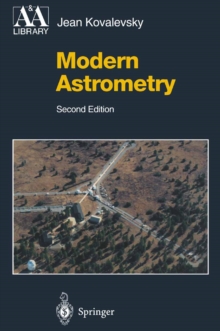

- #ASTROMETRY FOR ASTROPHYSICS PDF PDF#
- #ASTROMETRY FOR ASTROPHYSICS PDF PLUS#
- #ASTROMETRY FOR ASTROPHYSICS PDF FREE#
Hence, the chosen sample almost never represents the true distribution of sources in the astrophysical parameter space. Syllabus Requirements for VCE Astronomy and Astrophysics This paper uses the Physics. In addition, they may depend on the location on the sky or the source properties.

Both issues are related to the properties of the astrometric survey and how the sample is chosen. The main effects that can complicate the interpretation of astrometric data for samples of objects are summarized below.Īny sample chosen from an astrometric catalog will suffer from incompleteness in the data and selection effects.
#ASTROMETRY FOR ASTROPHYSICS PDF FREE#
This chapter is focused on discussing these complicating effects with the aim of providing guidance on the optimal use of astrometric data in statistical studies.Įffects complicating the interpretation of astrometric data Study astronomy online free by downloading OpenStaxs Astronomy book and using our accompanying online resources including an astronomy. However, there are a number of effects that can lead to errors in the inference of astrophysical quantities and thus complicate the interpretation of astrometric data. Astronomers in Chilean institutions have access to 10 of telescope-time on each of these instruments, thanks to. 353, 元7L40 (2000) ASTRONOMY AND ASTROPHYSICS Letter to the Editor VLBI difference astrometry at 43GHz J.C. These studies become especially interesting now that astrometric catalogs are available with large numbers of parallaxes. The applications are numerous and include luminosity calibration, star-cluster membership determination, separating the Galaxy's structural components, detecting low-contrast substructure in the Galactic halo, etc. Often the mean value of the astrophysical quantity or a description of its distribution is sought. These improvements will again challenge the models for the celestial reference system.The term “statistical astrometry” refers to the inference of astrophysical quantities from samples (i.e.

Increases in the precision of measurements from astrometric space missions will further improve the celestial reference frame and may require its redefinition within the next ten years. such as radio astronomy, astrophysics, astrometry, astrospectroscopy, space geodesy, big data and astronomical imaging, providing vast and fascinating. The astrometric foundation of astrophysics was revolutionized by the observations 198993 with ESAs Hipparcos astrometry satellite. It is important to note that, because most of.
#ASTROMETRY FOR ASTROPHYSICS PDF PLUS#
Manuel Vogel, TU Darmstadt and GSI Darmstadt. astronomy and planetary science, the cosmology and the physics background, plus two chapters of mathematics. Astrometry through photometry will measure a light flux received from one or several bodies, related to their relative positions. Only radar or laser are able to measure directly distances in kilometers.
#ASTROMETRY FOR ASTROPHYSICS PDF PDF#
van Altena 5178 2012 428 pages PDF 3 MB The field of astrometry, the precise measurement of the positions, distances and motions of astronomical objects, has been revolutionized in recent years. The precision with which the ICRF is now determined requires that the ICRS models for precession, nutation, and others, be revised. Cambridge University Press (2013) 411 pages, price 85 USD, hardcover ISBN 9780521519205 Dr. Astrometry is usually measuring an angular distance on the celestial sphere. PDF 2012 Cambridge ISBN-10: 0521519209 Astrometry for Astrophysics: Methods, Models, and Applications By William F. At optical wavelengths, the Hipparcos catalog is the realization of this frame. The ICRF defines the direction of the axes of the International Celestial Reference System (ICRS) with a precision of approximately 20 muas. This new frame, the International Celestial Reference Frame (ICRF), is based on the radio positions of 212 compact extragalactic radio sources. Advances in wide-angle astrometric measurements of three to four orders of magnitude in the last thirty years have resulted in a redefinition of the fundamental astronomical reference frame.


 0 kommentar(er)
0 kommentar(er)
